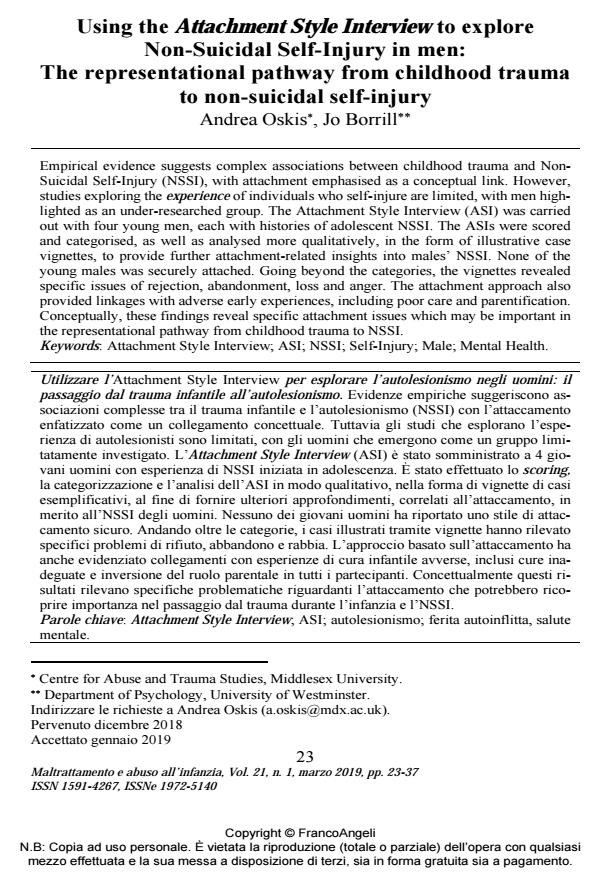Using the Attachment Style Interview to explore Non-Suicidal Self-Injury in men: The representational pathway from childhood trauma to non-suicidal self-injury
Journal title MALTRATTAMENTO E ABUSO ALL’INFANZIA
Author/s Andrea Oskis, Jo Borrill
Publishing Year 2019 Issue 2019/1
Language English Pages 15 P. 23-37 File size 241 KB
DOI 10.3280/MAL2019-001003
DOI is like a bar code for intellectual property: to have more infomation
click here
Below, you can see the article first page
If you want to buy this article in PDF format, you can do it, following the instructions to buy download credits

FrancoAngeli is member of Publishers International Linking Association, Inc (PILA), a not-for-profit association which run the CrossRef service enabling links to and from online scholarly content.
Empirical evidence suggests complex associations between childhood trauma and Non-Suicidal Self-Injury (NSSI), with attachment emphasised as a conceptual link. However, studies exploring the experience of individuals who self-injure are limited, with men high-lighted as an under-researched group. The Attachment Style Interview (ASI) was carried out with four young men, each with histories of adolescent NSSI. The ASIs were scored and categorised, as well as analysed more qualitatively, in the form of illustrative case vi-gnettes, to provide further attachment-related insights into males’ NSSI. None of the young males was securely attached. Going beyond the categories, the vignettes revealed specific issues of rejection, abandonment, loss and anger. The attachment approach also provided linkages with adverse early experiences, including poor care and parentification. Conceptu-ally, these findings reveal specific attachment issues which may be important in the repre-sentational pathway from childhood trauma to NSSI.
Keywords: Attachment Style Interview; ASI; NSSI; Self-Injury; Male; Mental Health.
- Impacts of childhood maltreatment in adulthood Antonia Bifulco, Nollaig Frost, in MALTRATTAMENTO E ABUSO ALL'INFANZIA 2/2019 pp.7
DOI: 10.3280/MAL2019-002001 - Emotional Consequences of Participating in Research: How Does a History of Non-Suicidal Self-Injury and Trauma Exposure Affect Participants’ Experiences? Ryan A. Robertson, M. Shae Nester, Christina M. Dardis, in Journal of Empirical Research on Human Research Ethics /2021 pp.105
DOI: 10.1177/1556264620979618
Andrea Oskis, Jo Borrill, Using the Attachment Style Interview to explore Non-Suicidal Self-Injury in men: The representational pathway from childhood trauma to non-suicidal self-injury in "MALTRATTAMENTO E ABUSO ALL’INFANZIA" 1/2019, pp 23-37, DOI: 10.3280/MAL2019-001003